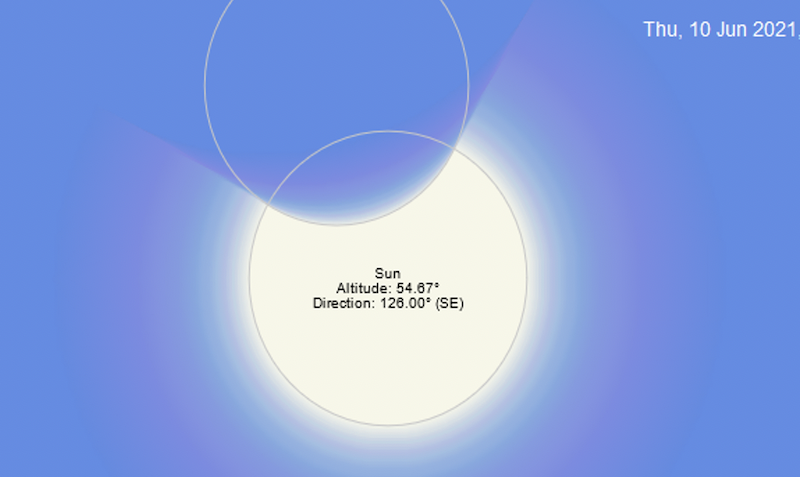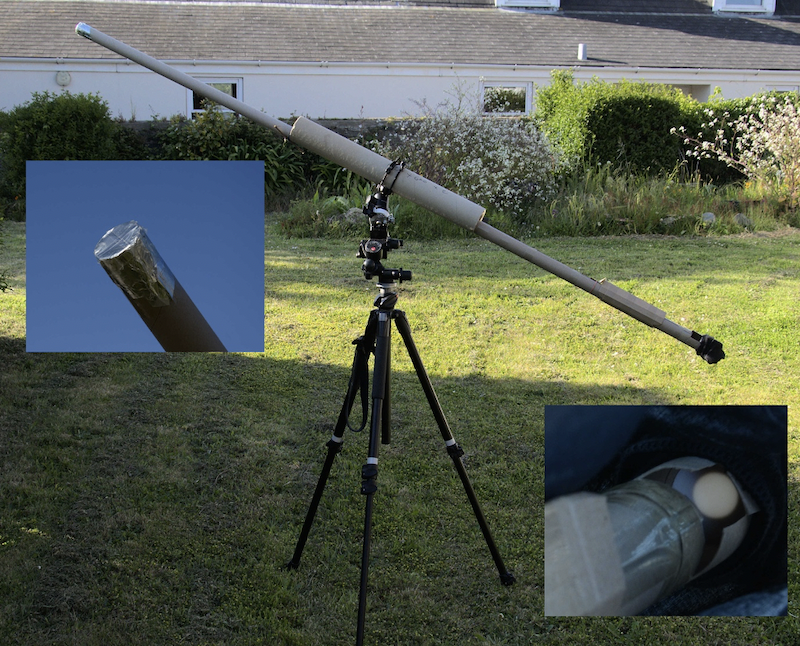

This morning's partial solar eclipse is starting to break through after early morning cloud cover.
The partial eclipse was due to start in Guernsey about 10:03, with maximum 29.5% eclipse at 11:05, and finish about 12:12.
Elaine Mahy from the Astronomy Section of La Société said the sun would be in the east at the start of the eclipse, before rising high to the south.

Pictured: Eclipse details from https://www.timeanddate.com – maximum eclipse from Guernsey is shown.
"The eclipse will appear as if the Sun has a growing, and then diminishing, 'bite' out of it," said Mrs Mahy ahead of the eclipse. "As we will be looking at the shadowed side of the moon, the moon itself will not be visible except in silhouette where it overlaps the Sun.
"Do not look at the sun directly or through any optical equipment," she emphasised.
While Guernsey will be nearer the edge of the eclipse, countries that lie in its full path will be able to see a 'ring of fire'.
"As the moon is at a further point in its orbit, it will not fully cover the sun and through maximum will be seen as an annular eclipse, leaving a 'ring of fire' of sun visible at maximum eclipse. The annular eclipse will be visible from parts of northern Canada, Greenland, and northeastern Russia."

Pictured: A Partial Solar Eclipse – the end of the Great American Eclipse of 21 August 2017, taken at sunset from Pleinmont, Guernsey - by Elaine Mahy Sunspots are visible in this shot taken with a Baader Astrosolar Safety Film filter over a 600mm camera lens. The moon is visible in silhouette, overlapping as a dark “bite” across the Sun.
There are various ways to view the sun and a partial solar eclipse safely, for example:
1) Eclipse glasses. If you have a pair of solar eclipse glasses, in good condition, you can use these to view the sun’s outline safely for a limited time. Just don’t try walking around whilst wearing them, as you can’t see anything else!
2) Simple pin hole projection. Use two pieces of card: a dark card with a neat pin hole, held in view of the Sun, and in its shadow hold a white card to display the tiny image. The further apart the cards are, the bigger, but dimmer, the image.
3) Pin hole projection in a box or tube, for better contrast. You can find guides for this online. This will project a small image of the sun through a pin hole in foil in the sunny end of the box, onto the inside of the far end of the box, which you can view through a side cut-out in the box. Placing a white card inside at the display end produces a brighter image. The longer the box or tube, the larger the image, though it may become less crisp and bright and will be more difficult to find and keep centred.
4) Mirror reflector. Cover a small flat mirror with black paper or card, leaving just a tiny cutout no more than 5mm across. You could use a small hole punch but any shape hole will do – this will act as a pinhole that you can use to reflect an image of the sun onto a shaded white wall – experiment using different distances between mirror and wall and see how big a reflected projection you can make without losing too much detail.

Pictured: A long pinhole projector made from cardboard tubes and set on a tripod with tracking to keep the image in view – this setup produces a 2cm diameter image of the Sun, enough to show the shape of a partial eclipse.
5) Use a tree or colander or interlaced fingers as a multi-pinhole projector. For example stand in the shade of a tree that lets small glimpses of the sun shine onto the ground. During the partial eclipse you will see instead of glimmering circles, crescents, though these will be stretched as the ground lies at an angle away from the sun. You can also try this method with interlaced fingers, leaving tiny gaps, or by punching random small holes into a piece of card.
6) Binocular or telescope projection. If you have a small telescope or binoculars and a tripod, you may be able to project a larger image of the sun onto white card – but as this may damage your equipment, please research this properly first, it is at your risk. Make sure no-one can look through directly as this is very dangerous.
7) Solar filters are available to safely view the Sun through binoculars or a telescope on a tripod, or to cover a lens on a camera. Or for a less expensive option, construct your own solar filter with dedicated solar filter film such as Baader AstroSolar Safety Film. Make any sun filter is fitted securely and preferably taped on.
8) Weather and logistics permitting, we may run an Open Morning at Guernsey Astronomical Observatory on the morning of Thursday 10 June to watch the eclipse and demonstrate various ways to safely observe the Sun. We would observe the partial eclipse, and also follow online the full annular eclipse. Look out for details of the Open Morning closer to the time if the weather looks good. Or try to get a look at the eclipse from where you are using some of the safe viewing ideas above.
9) Look for live feeds or news of the eclipse. Amateur and professional observers of the annular eclipse will also post images online in the days afterwards, so do take a look.
Comments
Comments on this story express the views of the commentator only, not Bailiwick Publishing. We are unable to guarantee the accuracy of any of those comments.